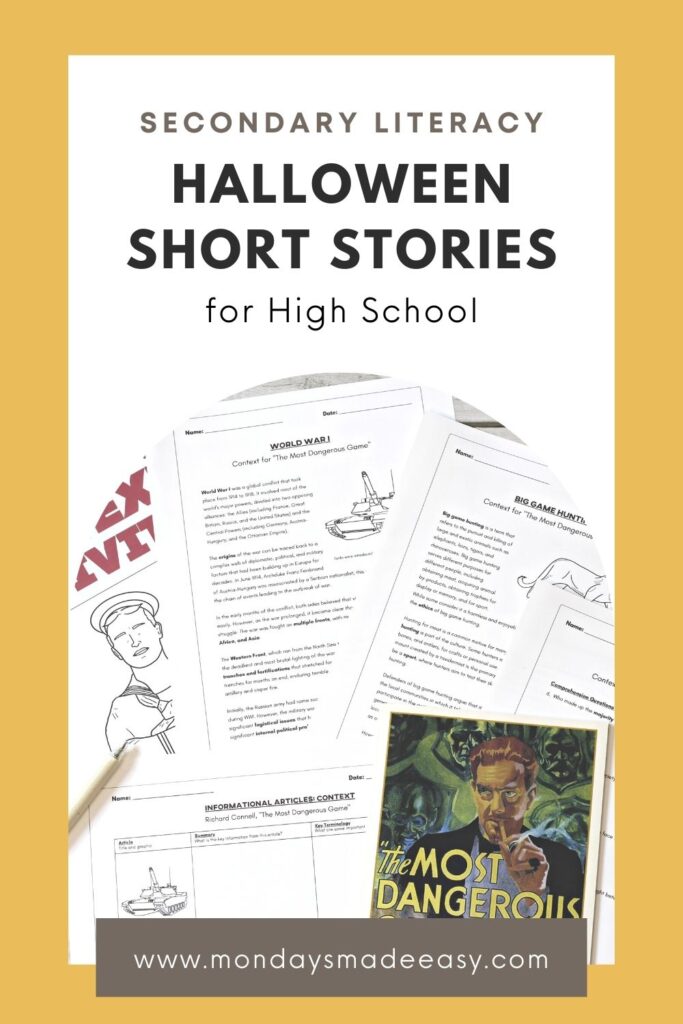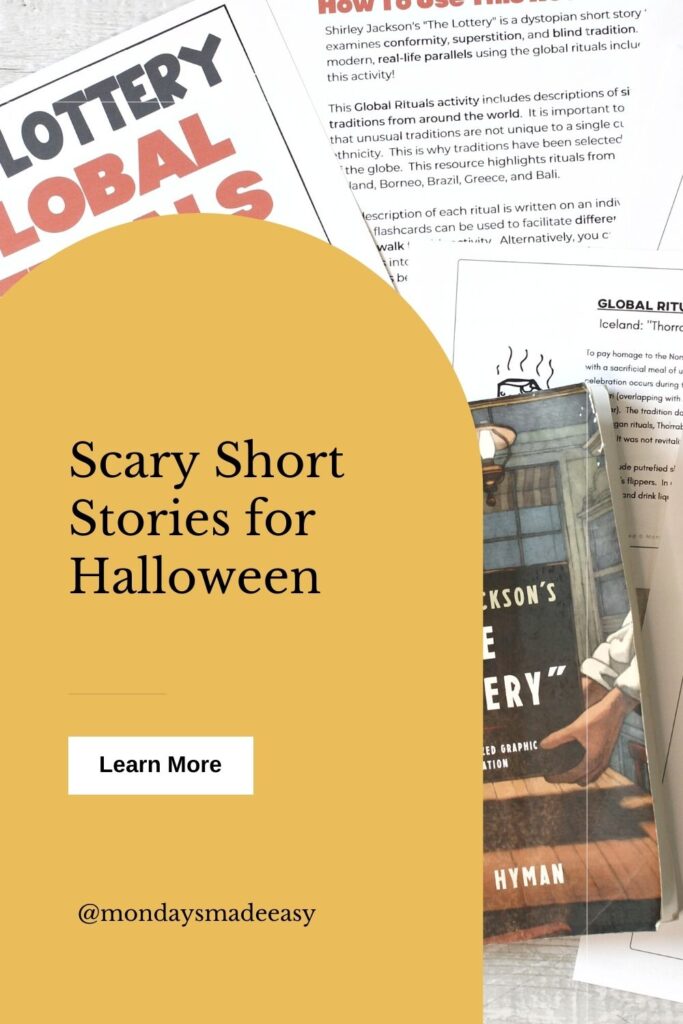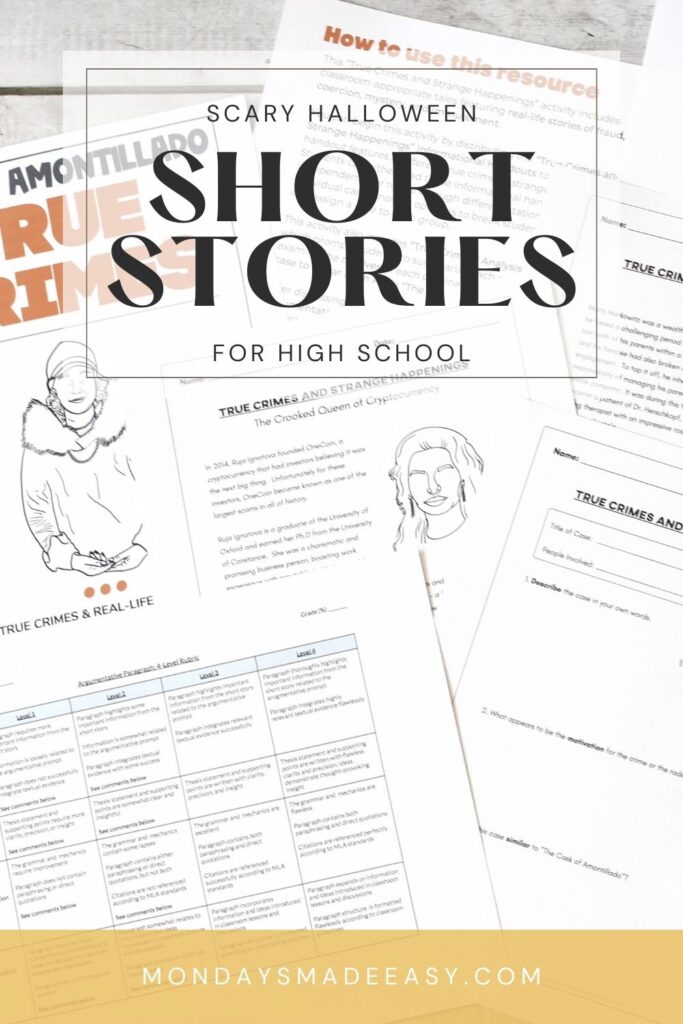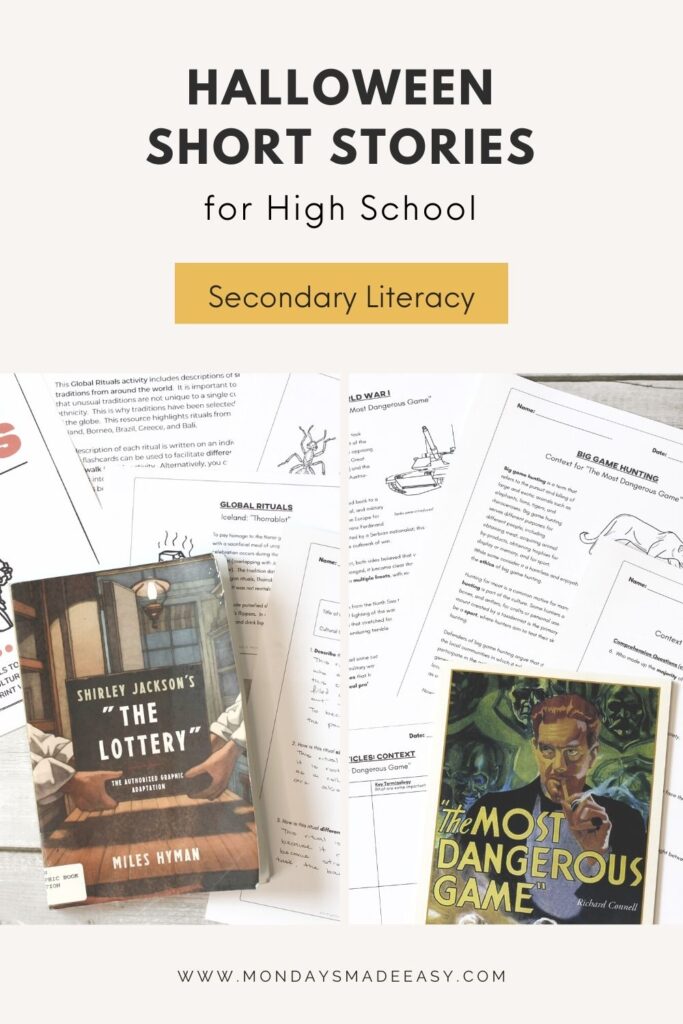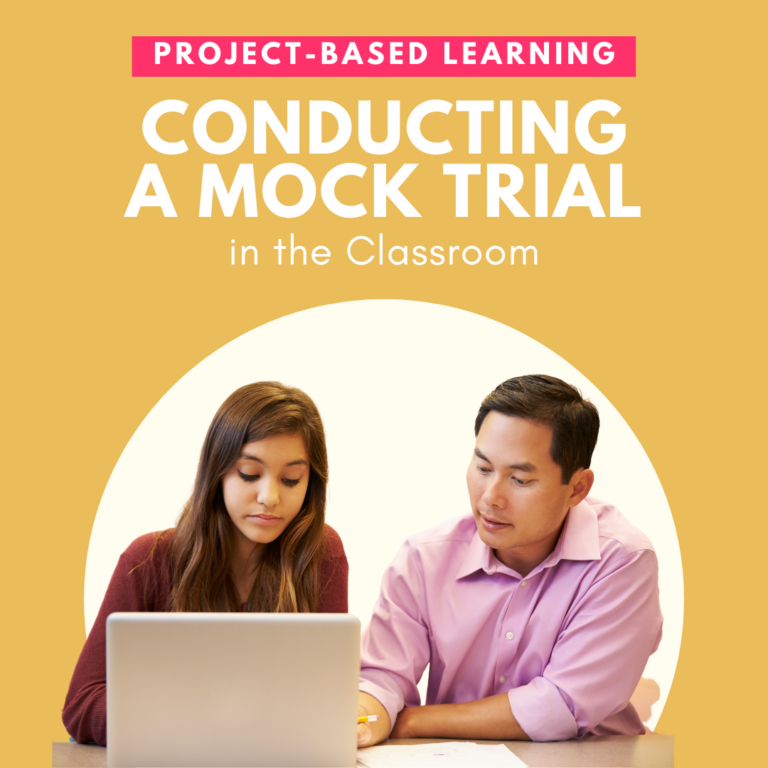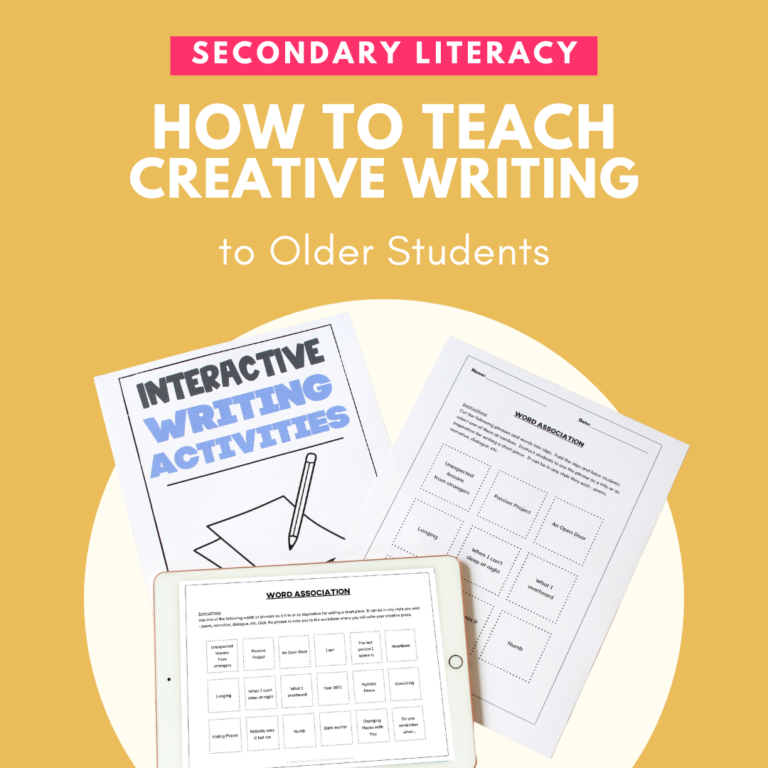What better way to re-invigorate students after the back-to-school rush than by incorporating some scary short stories for Halloween? Not only do Halloween short stories captivate high school students – they also seamlessly weave in literary elements like irony, character development, and setting; these devices lend their eerie ambiance to these tales.
In this blog post, I’ll share some classic Halloween short stories that are suitable for different grade levels in high school. Some stories are geared towards freshmen and sophomores, while others deal with concepts and themes that are more appropriate for juniors and seniors. Regardless of their level of complexity, each of these Halloween short stories evokes the darkness, mystery, and nostalgia of the season.
What are good Halloween short story ideas?
The best Halloween short stories have more to offer than just goblins and ghosts. Think about the deeper themes of Halloween: the dark side of humanity, the power of ancient rituals, and the thinning veil between life and death. The Halloween season sets the mood to explore these themes in depth.
If you’re looking for ideas for Halloween short stories, consider blurring the lines between reality and imagination by selecting texts with fully-developed characters and a sense of normalcy. This will encourage students to connect these lessons to their surroundings and question society’s norms.
Picking the right scary short story for school
Before diving into this list of Halloween short stories, it’s important to emphasize that selecting the appropriate activity requires careful consideration. While Halloween can be a time for creativity and fun, it’s important to remember that what might be entertaining for one student could be distressing or traumatic for another. Graphic or overly intense narratives might not sit well with every child.
Additionally, the topic of spirits and certain Halloween traditions might clash with the religious or cultural beliefs of some students. Being mindful of these potential conflicts can help create an inclusive environment where all students feel respected and comfortable. Let’s strive for a celebration that honours the diversity of our classroom and promotes understanding and respect for all.
Scary short stories to teach for Halloween
“The Lottery” by Shirley Jackson
In a fictional small American community, the townspeople host an annual tradition that is sure to give your students the creeps. One of the classic Halloween short stories by Shirley Jackson, it explores the dark side of conformity, superstition, and the human capacity for cruelty. When the townspeople gather for this yearly event, the true nature of the lottery is unveiled. Prepare to be gripped by a story that will leave students questioning the nature of society and the bounds of collective morality.
This dystopian short story examines collective morality, superstition, and blind tradition. Jackson brings the story to life through the use of literary devices such as imagery, symbolism, and contrast.
“The Lottery” is an engaging option for younger teenagers. With a text length of just over 3000 words and a Lexile level of 1030, this scary short story is suitable for most students in grades 7 to 9.
Compare and contrast the lottery with various real-life rituals from around the world with this global rituals activity. This comparison lesson includes informational handouts about six different traditions from around the world. It is important to emphasize that unusual traditions are not unique to a single culture or ethnicity; this is why traditions have been selected from all parts of the globe. This resource highlights rituals from Scotland, Iceland, Borneo, Brazil, Greece, and Indonesia.
The flashcards included with this lesson can be used to facilitate a station activity for groups to explore a different tradition. You can also create a gallery walk for students to rotate independently around the room. After completing this activity, students will be prompted to write a comparison paragraph about “The Lottery” and one of the global rituals that they learned about during this activity.
“Lamb to the Slaughter” by Roald Dahl
When a devoted housewife receives startling news from her husband, this seemingly congenial story takes a dark and unexpected twist. “Lamb to the Slaughter” by Roald Dahl is one of the most scary Halloween short stories that is a tale of ingenuity and the ironies of justice. With a weapon as unusual as it is ordinary, Dahl masterfully uncovers the thin line between love and vengeance. Your students will be at the edge of their seats during this creepy classic!
“Lamb to the Slaughter” examines identity, preconceived notions, and betrayal through the use of cunning characterization. With an unexpected twist at the heart of this story, this eerie classic is a strong choice for teaching irony.
“Lamb to the Slaughter” is just about 4000 words in length. With a Lexile level of 780, this scary short story is suitable for sophomores, freshmen, and even students in upper middle school.
Analyze Dahl’s brilliant use of irony with this free irony flow chart. This worksheet defines irony and differentiates between dramatic irony, situational irony, and verbal irony. Students will be prompted to locate evidence in the text to apply examples to teach type of irony, and analyze why these examples qualify as ironic.
“The Cask of Amontillado” by Edgar Allen Poe
In the shadowy recesses of a catacomb, a tale of a long-held grudge unfolds. With a recipe of deception, vengeance, and plenty of wine, Edgar Allen Poe’s “The Cask of Amontillado” is perhaps one of the all-time classic Halloween short stories. As Poe’s characters travel deeper into the catacombs, tension mounts and dark intentions are revealed.
This is one of the creepiest classic Halloween short stories that examines revenge and retribution. Rich with literary devices and figurative language, this story is a fantastic model for teaching verbal irony, foreshadowing, setting, and mood.
Although this short story ranks a Lexile level of 780, students will likely stumble upon plenty of new vocabulary words. This is why I typically teach “The Cask of Amontillado” in grades 10 and 11. These vocabulary worksheets are a great pre-reading activity to support students’ independent reading of this story.
You can differentiate between setting and mood in Edgar Allen Poe’s “The Cask of Amontillado” using this literary analysis activity. These handouts define mood as a literary device and explore how an author establishes mood within a story. Students will then practice interpreting mood by describing the mood of different types of settings. Students can also complete a graphic organizer for analyzing mood. This literary analysis activity includes seven close reading quotations from “The Cask of Amontillado” that students can analyze in order to describe how they contribute to the story’s mood.
Take this story to another level by exploring real-life parallels: this true crime activity pairs perfectly with “The Cask of Amontillado.” This activity includes six nonfiction articles featuring tales of fraud, coercion, mystery, and immurement. These classroom-appropriate tales explore true crime and prompt students to consider common characteristics of criminals and radicals and evaluate common themes.
Halloween Short Stories for Seniors
“The Most Dangerous Game” by Richard Connell
On a secluded island in the Caribbean Sea, you are either the hunter or the hunted. “The Most Dangerous Game” by Richard Connell is one of the most thrilling Halloween short stories about survival and primal instincts. When a shipwrecked big-game hunter becomes the prey in a deadly game of pursuit, the stakes rise beyond imagination – begging the reader to draw the line of morality in the sand.
This is one of the most exciting classic Halloween short stories, examining empathy, moral philosophy, and the impact of war. Connell’s use of setting and pathetic fallacy immerses students in the horror and cruelty of Shipwreck Island.
This short story is longer in length than most. This is one of the reasons why I like to explore “The Most Dangerous Game” with juniors and seniors in high school. Understanding the context of this story also allows students to dive deeper into the overarching themes. Older students may have more success with drawing parallels between history and “The Most Dangerous Game.” To foster these connections, it can be helpful to explore nonfiction articles about World War I, sailor lore, big-game hunting, and other circumstances that relate to this short story.
You can guide students to a deeper understanding of the message beneath this short story by facilitating a mock trial assignment. This assignment teaches students about the legal system while exploring justice and morality in “The Most Dangerous Game.” Through the trial of S. Rainsford v. The State of New York, students will critically evaluate the motives of Connell’s characters.
“The Yellow Wallpaper” by Charlotte Perkins Gilman
A woman’s descent into hysteria becomes a chilling reflection of societal oppression, blurring the lines between horror and real-life. Charlotte Perkins Gilman’s 19th-century classic peels back the layers of obsession, confinement, and the search for autonomy. As the room’s intricate wallpaper becomes an all-consuming fixation, readers are pulled into the protagonist’s downward spiral.
“The Yellow Wallpaper” examines women’s health, subordination in marriage, and the culture of domesticity. This short story is also a great vehicle for teaching literary devices like personification, euphemism, irony, and extended metaphor.
Similar to “The Most Dangerous Game,” students are able to dive deeper into “The Yellow Wallpaper” once they’ve obtained a more mature understanding of history. Originally written in 1892, the diction used in “The Yellow Wallpaper” may also not feel familiar to your students. This is why I find “The Yellow Wallpaper” to be a rigorous short story to explore with juniors and seniors. These free vocabulary worksheets are a helpful pre-reading activity to support students with this story.
A major symbol in this story is the yellow wallpaper itself. After discussing the themes in “The Yellow Wallpaper,” you can prompt students to design their own piece of haunting wallpaper. This design should incorporate patterns or images that they feel represent themes from the story or emotions of the protagonist. Once everyone has completed their wallpaper design, students can take turns presenting their designs to the class. Students can explain the symbolism in their design and how it relates to the story.
Teaching Short Stories during Halloween
Scary season is an opportune time to incorporate some classic Halloween short stories into your curriculum. This age-old celebration brings folklore to the forefront, lending well to storytelling and literary analysis. I hope this blog post has inspired you to invite the spirit of the season into your classroom.
To shop the lesson plans and activities explored in this blog post, check out this Scary Halloween Short Story Unit.

